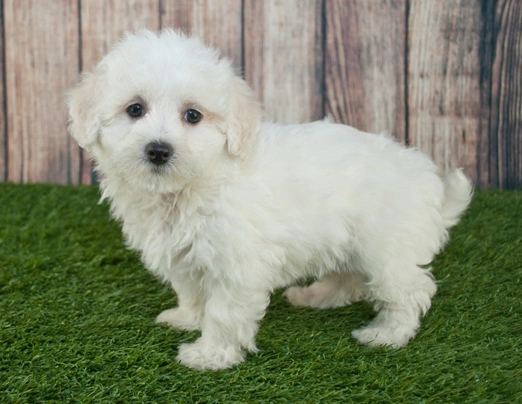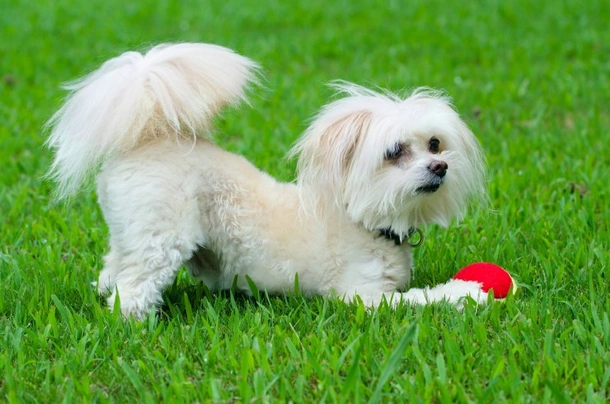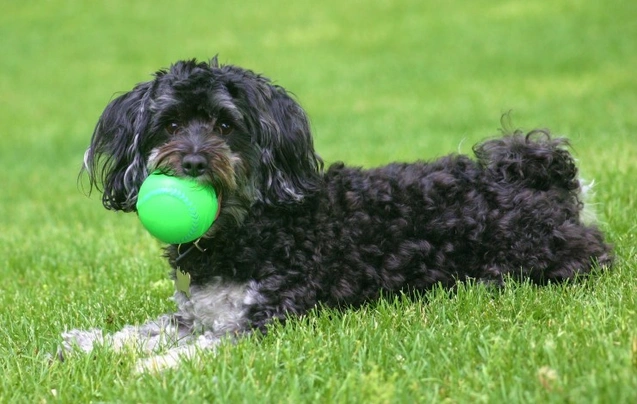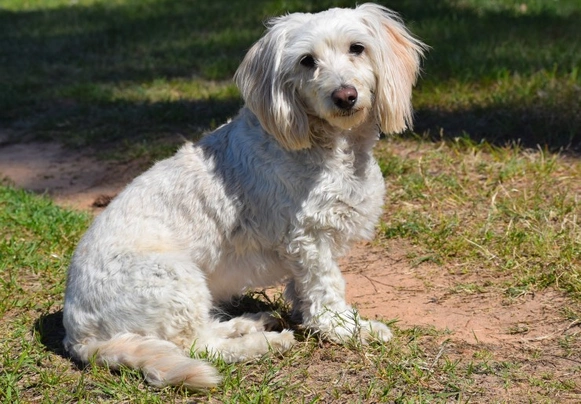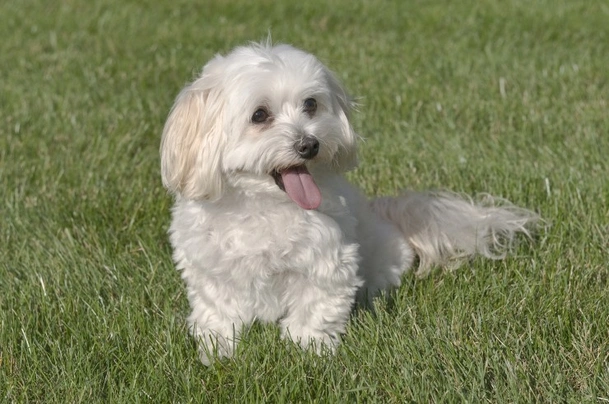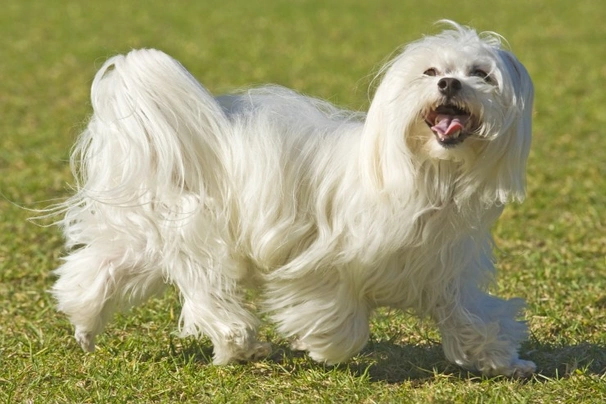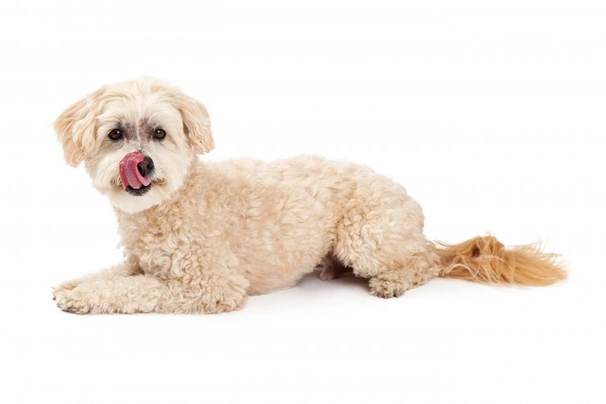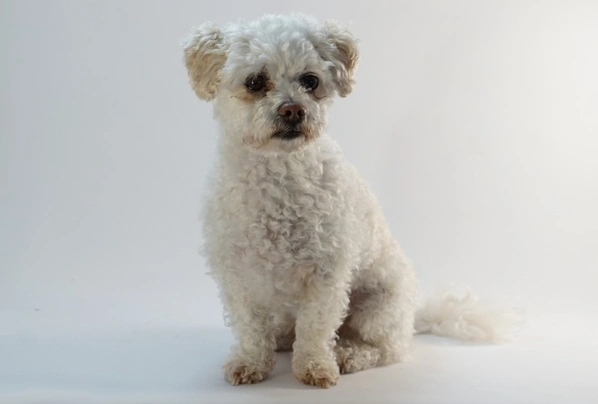Maltipoo
Pros
Cons
Introduction of the Maltipoo
The Maltipoo is a small and very popular cross breed that's relatively new to the dog scene with their parent breeds being the Toy or Miniature Poodle and the Maltese both of which are pure breeds. Over the years these charming little dogs have found their way into the hearts and homes of people throughout the world thanks to their adorable looks and the fact they have inherited many of their parent breeds traits which includes their intelligence and playfulness.
The Maltipoo is not Kennel Club registered as a breed (October 2017) but their popularity has seen more dogs being bred in the UK and elsewhere in the world. Today there are first second third and fourth generation Maltipoos on the scene and it's essential that all prospective owners contact reputable breeders who only use health tested parent breeds which is the only way of ensuring that puppies are less likely to inherit any health concerns known to affect parent breeds.
History of the Maltipoo
The Maltipoo is among the more recent deliberate crossbreeds to have appeared on the scene over recent years. They were first bred in the States to be companions and family pets that boasted having low and non-shedding coats which meant that people who usually suffered from pet-related allergies would be able to share their homes with a small sized canine companion. However the jury is still out as to whether Maltipoos are as hypoallergenic as they were first thought to be.
Over time these charming little dogs found their way into the hearts and homes with many people all over the world whether they suffered from allergies or not because Maltipoos are so adorable both in looks and natures. They have also proved to be a firm favourite with many celebrities too. As yet the Maltipoo is not recognised as a breed in its own right by The Kennel Club (October 2017) or other international breeds clubs. However a North American Club & Registry has been founded with an end goal being to continue to breed healthy first second third and fourth generation Maltipoos.
Interesting facts about the breed
- Is the Maltipoo a vulnerable breed? No they are now among some of the more popular dogs in the UK being ranked 82 out of 238 breeds on the Pets4homes website
- Maltipoos are known to have low shedding coats which means they are good choice for people who suffer from allergies being classed as hypoallergenic dogs
- Today there are first generation (f1) Maltipoos second generation third and fourth generation Maltipoos but what are considered the healthiest are first generation dogs
- They retain their puppy-like personalities well into their senior years
- Many celebrities and famous people own Maltipoos which includes Rhianna who has a dog called "Oliver"
Appearance of the Maltipoo
Height at the withers: Males 20.32 - 35.56 cm Females 20.32 - 35.56 cm
Average weight: Males 2.26 - 9.07 kg Females 2.26 - 9.07 kg
Maltipoos are delightful dogs with some being much smaller than others because it depends on which of the parent breeds they throw to. Puppies from the same litter can be quite different looking for this very reason with some boasting tight curly coats that shed little much like the Poodle whereas another puppy might have more of the Maltese type coat. However over the years multi-generational Maltipoos have become available which in turn has created more of a standardised look about them.
Their heads are nicely in proportion with the rest of their bodies. They have dark round eyes and short muzzles nicely finished off with dark noses and dark coloured tight lips. Their ears are set high and wide apart on a dog's head falling forwards when alert or excited but hanging down to the side when they are relaxed. The Maltipoo has a strong jaw with a perfect scissor bite where their upper teeth neatly overlap their lower ones.
They have quite broad chests for such small dogs and straight short but strong front legs. Shoulders are nicely laid back with Maltipoos having level backs and rounded loins. Their bellies are slightly tucked up adding to their athletic appearance and back legs are well muscled and strong. Feet are small and very cat-like with strong nails and paw pads.
When it comes to their coat the Maltipoo can either have a very tight curly coat or a much looser wavy coat but they can have a mixture of the two because it depends on which of the parent breeds they throw to. With this said the most commonly seen colours in the Maltipoo are as follows:
- Cream
- White
- Silver
- Apricot
- Black
- Brown
- Cafe au Lait
- Grey
- Red
- Silver beige
- Phantom
- Blue
Gait/movement
When a Maltipoo moves they do so with great drive and purpose. They are always gay and alert giving the impression of wanting to be involved in everything that goes on around them.
Faults
Prospective Maltipoo owners should be wary of any puppies or dogs that show any sort of exaggeration whether in their looks or conformation and that extra-small Maltipoos often come with many health issues so they are best avoided. A responsible breeder would always ensure that puppies they produce are of a good size and conformation and would avoid breeding extra small dogs for these reasons. Males should have both testicles fully descended into their scrotums.
Temperament of the Maltipoo
Maltipoos have inherited the intelligence of both parent breeds but they have also inherited the friendly and loving natures of the Poodle and the Maltese too. They are extremely people-oriented loving nothing more than to be with their owners as much as possible which although endearing can become a bit of a problem when they are left on their own for longer periods of time. Maltipoos can develop separation anxiety which can result in them becoming stressed out and destructive around the home as a way of relieving their stress when they find themselves on their own.
They are a good choice for first time owners providing they have the time needed to be with their pets. As such Maltipoos thrive in households where at least one person stays at home when everyone else is out of the house. They are not the best choice for families with very young children because they can be a bit "snappy" when things get too noisy and boisterous. However they fit in well to households where the children are older and who therefore know how to behave around dogs.
Maltipoos like the sound of their own voices which is a behaviour that needs to be gently nipped in the bud when a dog is still young to prevent it becoming a real problem when they are mature older dogs. It's very important that both parent dogs are kind and friendly by nature so that puppies inherit their affectionate natures which is why it's essential to meet both parent dogs before getting a Maltipoo puppy.
A puppy's socialisation must start early as does their training starting with the basics as soon as they arrive in their new home. Once they have been fully vaccinated it's important to introduce them to lots of new situations noises people other animals and pets so they grow up to be calmer well-rounded mature dogs. Their training can also start in earnest once they have had all their shots and a good way of getting things off to the right start is to enroll dogs into puppy classes. This is a great way of continuing their socialisation while at the same time training them in a safe and controlled environment surrounded by other dogs and people.
Are they a good choice for first time owners?
Maltipoos are a good choice for first time dog owners because they are so amenable and people-oriented loving nothing more than to please and to entertain their families. However they hate being left on their own which means they are not a good choice for anyone who spends a lot of time out of the home. With this said they can be a little "snappy" when they are around very small children because they don't like being pulled about. With this said Maltipoos are a great choice as companions for the elderly.
What about prey drive?
Maltipoos are very social by nature and even though they have working and hunting dogs in their lineage they do not have a very high prey drive. However this is not to say that a dog would not give chase to a smaller animal when the mood takes them and this includes squirrels and the cat from next door and introductions to smaller animals and pets should always be carried out with care.
What about playfulness?
Maltipoos have a very playful side to their natures and love to entertain and be entertained. They can be very mischievous when the mood takes them and quickly learn what pleases their owners and how much they can get away with loving nothing more than to test the boundaries with their silly playful antics.
What about adaptability?
Maltipoos are highly adaptable dogs providing they are given enough daily physical exercise combined with as much mental stimulation to prevent boredom from setting in which could result in destructive behaviour around the home and dogs barking incessantly.
What about separation anxiety?
Maltipoos form strong ties with their families and dogs are never very happy when they find themselves left on their own for longer periods of time. They are better suited to people who either work from home or in households where one person stays at home when everyone else is out so they are never alone for any length of time which could see a dog suffering from separation anxiety. This can lead to them being destructive around the home which is a dog's way of relieving any stress they are feeling and a way to keep themselves entertained.
What about excessive barking?
Maltipoos are known to like the sound of their own voices a little too much which is something that needs to be gently nipped in the bud when a dog is still young being careful not to frighten them. Others will only bark when there are strangers about or when something they don't like is going on in their surroundings.
Do Maltipoos like water?
Most Maltipoos love swimming and will take to the water whenever they can more especially when the weather is hot. However if anyone who owns a dog that does not like water should never force them to go in because it would just end up scaring them. With this said care should always be taken when walking a Maltipoo off the lead anywhere near more dangerous watercourses just in case a dog decides to leap in and then needs rescuing because they cannot get out of the water on their own.
Are Maltipoos good watchdogs?
Maltipoos are not natural watchdogs although this is not to say a dog would not be quick off the mark to let an owner know when there are strangers about although they would rarely do this aggressively preferring to stand back and bark to alert their owners.
Intelligence / Trainability of the Maltipoo
It's all too easy to let a Maltipoo get away with things that larger dogs would never be allowed to do which can result in these cute little dogs developing a condition known as "small dog syndrome". It can make dogs very hard to live with because they become wilful and unruly. However in the right hands and environment Maltipoos being so intelligent are easy to train and love the one-to-one attention they are given during their training sessions and love nothing more than to show off to the crowd.
Being so intelligent Maltipoos are quick learners but the downside to this is they are just as quick to pick up bad behaviours and habits too which is why their training must be consistent from the word go and throughout their lives. They are sensitive little dogs by nature and as such they do not answer well to any sort of harsh correction or heavier handed training methods. They do respond extremely well to positive reinforcement especially when it involves receiving a high value treat. Because Maltipoos are prone to putting on too much weight it's important to keep food rewards to a minimum and to offer fewer high value ones rather than lots of lower value ones.
As previously mentioned Maltipoo puppies are incredibly cute and it is all too easy to spoil them but it would be mistake to let a puppy get away with too much. The reason being that like many smaller breeds Maltipoos can develop "small dog syndrome" which can make them unruly wilful and harder to live with. All puppies and older dogs are much happier and well-behaved when they know what owners expect of them. As such limits and boundaries should be set right from the word go and this includes teaching a Maltipoo puppy their first commands which are as follows:
- Come
- Sit
- Stay
- Quiet
- Leave it
- Down
- Bed
Children and other
Maltipoos are best suited to families where the children are slightly older because they can be a little snappy around toddlers and younger children especially if the kids start playing a little too roughly with them. Any interaction between young children and a dog should always be supervised by an adult to make sure things don't get too boisterous which could end up with a Maltipoo getting a bit “snappy”.
If well socialised from a young enough age Maltipoos generally get on with other dogs they meet and if they grow up with a family cat in the home they usually get on well together. However they would not think twice about chasing off any other cats they come across. Care must be taken when they are around smaller animals and pets just to be on the safe side although most Maltipoos don’t have prey drives but they do love chasing things.
Health of the Maltipoo
The average life expectancy of a Maltipoo is between 10 and 15 years when properly cared for and fed an appropriate good quality diet to suit their ages.
The Maltipoo could be prone to certain hereditary and congenital health issues that affect parent breeds. These could include the following:
Maltese health issues
- Chiari malformation syringomyelia - dogs can be screened for the condition
- Acquired tremour syndrome
- Necrotising meningoencephalitis
- Myxomatous degeneration of the mitral valve
- Patent ductus srteriosus
- Pylonic stenosis
- Portosystemic shunt
- Cataracts
- Entropion
- Hydrocephalus
- Patellar luxation
- Hereditary deafness - dogs should be BAER tested through the Animal Health Trust
- Hypothyroidism
Miniature Poodle health issues
- Addison's Disease - a condition that negatively impacts a dog's adrenal glands
- Cushing's Syndrome - a condition where a dog's adrenal glands overproduce cortisol
- Thyroid disease
- Chronic active hepatitis - a liver disorder
- Seizures - idiopathic epilepsy
- Hip dysplasia - test available
- Hypothyroidism
- Von Willebrand's disease - DNA test available
- Legg-Calve-Perthes disease
- Patellar luxation
- Progressive retinal atrophy (PRA) - test available
- Achondroplasia
- Dental issues
Toy Poodle health issues
- Diabetes Mellitus
- Distichiasis
- Hyperadrenocorticism
- In-growing eye lashes
- Epilepsy
- Legge Perthes disease
- Progressive retinal atrophy (PRA) – Breeders should have stud dogs DNA tested
- Von Willebrands Disease (vWD) Type 1 - test available
- Ear problems
- Skin tumours
- Cataracts
- Cushing’s disease
- Bladder stones
What about vaccinations?
Maltipoo puppies would have been given their initial vaccinations before being sold but it is up to their new owners to make sure they have their follow-up shots in a timely manner with the vaccination schedule for puppies being as follows:
- 10 -12 weeks old bearing in mind that a puppy would not have full protection straight away but would be fully protected 2 weeks after they have had their second vaccination
There has been a lot of discussion about the need for dogs to have boosters. As such it's best to talk to a vet before making a final decision on whether a dog should continue to have annual vaccinations which are known as boosters.
What about spaying and neutering?
A lot of vets these days recommend waiting until dogs are slightly older before spaying and neutering them which means they are more mature before undergoing the procedures. As such they advise neutering males and spaying females when they are between the ages of 6 to 9 months old and sometimes even when a dog is 12 months old.
Other vets recommend spaying and neutering dogs when they are 6 months old but never any earlier unless for medical reasons. With this said many breeds are different and it is always advisable to discuss things with a vet and then follow their advice on when a dog should be spayed or neutered.
What about obesity problems?
Some Maltipoos gain weight after they have been spayed or neutered and it's important to keep an eye on a dog's waistline just in case they do. If a dog starts to put on weight it's important to adjust their daily calorie intake and to up the amount of exercise they are given. Older dogs too are more prone to gaining weight and again it's essential they be fed and exercised accordingly because obesity can shorten a dog's life by several years. The reason being that it puts a lot of extra strain on a dog's internal organs including the heart.
What about allergies?
Maltipoos are prone to suffering from allergies and it's important for a dog to see a vet sooner rather than later if one flares up. Allergies can be notoriously hard to clear up and finding the triggers can be challenging. With this said a vet would be able to make a dog with an allergy more comfortable while they try to find out the triggers which could include the following:
- Certain foods that contain high levels of grain and other cereal fillers
- Airborne pollens
- Dust mites
- Environment
- Flea and tick bites
- Chemicals found in everyday household cleaning products
Participating in health schemes
All responsible Maltipoo breeders would ensure that their stud dogs are tested for known hereditary and congenital health issues known to affect the breed by using the following schemes:
Maltese
- Hereditary deafness through the Animal Trust
- Chiari malformation syringomyelia
Miniature Poodle
- DNA test - prcd-PRA
- BVA/KC/ISDS Eye Scheme
- Hip scoring for hip dysplasia
- DNA test for Von Willebrand's disease
Toy Poodle
- DNA test - prcd-PRA
- BVA/KC/ISDS Eye Scheme
- BVA/KC Hip Dysplasia Scheme
- Breed Club test - Sebaceous adenitis
- DNA test - vWD
What about breed specific breeding restrictions?
There are no breed specific breeding restrictions in place for the Maltipoo but all breeders should follow the Kennel Club breeding recommendations even though Maltipoos are not KC recognised to ensure puppies are responsibly bred.
What about Assured Breeder Requirements?
There are no Assured Breeder requirements in place for Maltipoos because they are not a Kennel Club registered breed. However all prospective owners should contact reputable breeders who routinely have their stud dogs tested for known hereditary and congenital health issues known to affect the Maltese and the Poodle.
Caring for the Maltipoo
As with any other breed Maltipoos need to be groomed on a regular basis to make sure their coats and skin are kept in top condition. They also need to be given regular daily exercise to ensure they remain fit and healthy. On top of this dogs need to be fed good quality food that meets all their nutritional needs throughout their lives.
Caring for a Maltipoo puppy
Maltipoo puppies are boisterous and full of life which means it's essential for homes and gardens to be puppy-proofed well in advance of their arrival. A responsible breeder would have well socialised their puppies which always leads to more outgoing confident and friendly dogs right from the word go. With this said any puppy is going to feel vulnerable when they leave their mother and littermates which must be taken into account. The longer a puppy can remain with their mother the better although it should never be for too long either.
It's best to pick a puppy up when people are going to be around for the first week or so which is the time needed for a puppy to settle in. Puppy-proofing the home and garden means putting away any tools and other implements that a boisterous puppy might injure themselves on. Electric wires and cables must be put out of their reach because puppies love chewing on things. Toxic plants should be removed from flowerbeds and the home too.
Puppies need to sleep a lot to grow and develop as they should which means setting up a quiet area that's not too out of the way means they can retreat to it when they want to nap and it's important not to disturb them when they are sleeping. It's also a good idea to keep "playtime" nice and calm inside the house and to have a more active "playtime" outside in the garden which means puppies quickly learn to be less boisterous when they are inside.
The documentation a breeder provides for a puppy must have all the details of their worming date and the product used as well as the information relating to their microchip. It is essential for puppies to be wormed again keeping to a schedule which is as follows:
- Puppies should be wormed at 6 months old
- They need to be wormed again when they are 8 months old
- Puppies should be wormed when they are 10 months old
- They need to be wormed when they are 12 months old
Things you'll need for your puppy
There are certain items that new owners need to already have in the home prior to bringing a new puppy home. It's often a good idea to restrict how much space a puppy plays in more especially when you can't keep an eye on what they get up to bearing in mind that puppies are often quite boisterous which means investing in puppy gates or a large enough playpen that allows a Maltipoo puppy the room to express themselves while keeping them safe too. The items needed are therefore as follows:
- Good quality puppy or baby gates to fit on doors
- A good well-made playpen that's large enough for a puppy to play in so they can really express themselves as puppies like to do
- Lots of well-made toys which must include good quality chews suitable for puppies to gnaw on bearing in mind that a puppy will start teething anything from when they are 3 to 8 months old
- Good quality feed and water bowls which ideally should be ceramic rather than plastic or metal
- A grooming glove
- A slicker brush or soft bristle brush
- Dog specific toothpaste and a toothbrush
- Scissors with rounded ends
- Nail clippers
- Puppy shampoo and conditioner which must be specifically formulated for use on dogs
- A well-made dog collar or harness
- A couple of strong dog leads
- A well-made dog bed that's not too small or too big
- A well-made dog crate for use in the car and in the home that's large enough for a puppy to move around in
- Baby blankets to put in your puppy's crate and in their beds for when they want to nap or go to sleep at night
Keeping the noise down
All puppies are sensitive to noise including Maltipoo puppies. It's important to keep the noise levels down when a new puppy arrives in the home. TVs and music should not be played too loud which could end up stressing a small puppy out.
Keeping vet appointments
As previously mentioned Maltipoo puppies would have been given their first vaccinations by the breeders but they must have their follow up shots which is up to their new owners to organise. The vaccination schedule for puppies is as follows:
- 10 -12 weeks old bearing in mind that a puppy would not have full protection straight away but would only be fully protected 2 weeks after they have had their second vaccination
When it comes to boosters it's best to discuss these with a vet because there is a lot of debate about whether a dog really needs them after a certain time. However if a dog ever needed to go into kennels their vaccinations would need to be
What about older Maltipoos when they reach their senior years?
Older Maltipoos need lots of special care because as they reach their golden years they are more at risk of developing certain health concerns. Physically a dog's muzzle may start to go grey but there will be other noticeable changes too which includes the following:
- Coats become coarser
- A loss of muscle tone
- Maltipoos can either become overweight or underweight
- They have reduced strength and stamina
- Older dogs have difficulty regulating their body temperature
- They often develop arthritis
- Immune systems do not work as efficiently as they once did which means dogs are more susceptible to infections
Older dogs change mentally too which means their response time tends to be slower as such they develop the following:
- They respond less to external stimuli due to impaired vision or hearing
- They tend to be a little pickier about their food
- They have a lower pain threshold
- Become intolerant of any change
- Often an older dog can feel disorientated
Living with a Maltipoo in their golden years means taking on a few more responsibilities but these are easily managed and should include taking a look at their diet the amount of exercise they are given how often their dog beds need changing and keeping an eye on the condition of their teeth.
Older Maltipoos need to be fed a good quality diet that meets their needs at this stage of their lives all the while keeping a close eye on a dog's weight. A rough feeding guide for older dogs is as follows bearing in mind they should be fed highly digestible food that does not contain any additives:
- Protein content should be anything from 14 – 21%
- Fat content should be less than 10%
- Fibre content should be less than 4%
- Calcium content should be 0.5 – 0.8%
- Phosphorous content should be 0.4 – 0.7%
- Sodium content should be 0.2 – 0.4%
Older Maltipoos don't need to be given the same amount of daily exercise as a younger dog but they still need the right amount of physical activity to maintain muscle tone and to prevent a dog from putting on too much weight. All dogs need access to fresh clean water and this is especially true of older dogs when they reach their golden years because they are more at risk of developing kidney disorders.
Grooming of the Maltipoo
Maltipoos can have curlier coats or some can have straighter ones depending on which of their parent breeds they have thrown to but they all benefit from being given a brush every day which helps prevent any knots or tangles from forming. However dogs with very curly coats should ideally be professionally groomed on a regular basis which should be every 4 to 6 weeks or so to keep their coats and skin in good condition. It also makes it easier to keep their coats looking good that much easier in between visits to a grooming parlour.
It's also important to check a dog's ears on a regular basis and to clean them when necessary. If too much wax builds up in a dog's ears it can lead to a painful infection which can be hard to clear up. In short prevention is often easier than cure when it comes to ear infections.
Exercise of the Maltipoo
The Maltipoo is an active intelligent dog and as such they need to be given the right amount of daily exercise and mental stimulation for them to be truly happy well-rounded dogs. They need anything from 20 to 30 minutes exercise a day with as much off the lead time as possible. If they are not given the right amount of mental stimulation and exercise every day a Maltipoo would quickly get bored and could even begin to show some destructive behaviours around the home which is their way of relieving the stress they are feeling.
A shorter walk in the morning would be fine but a longer more interesting one in the afternoon is a must. These dogs also like to be able to roam around a back garden as often as possible so they can really let off steam. However the fencing must be extremely secure to keep these active little dogs in because if they find a weakness in the fence they will soon escape out and get into all sorts of trouble.
With this said Maltipoo puppies should not be over exercised because their joints and bones are still growing. This includes not letting a dog jump up and down from furniture or going up or down the stairs. Too much pressure placed on their joints and spines at an early age could result in a dog developing serious problems later in their lives.
Feeding of the Maltipoo
If you get a Maltipoo puppy from a breeder they would give you a feeding schedule and it's important to stick to the same routine feeding the same puppy food to avoid any tummy upsets. You can change a puppy's diet but this needs to be done very gradually always making sure they don't develop any digestive upsets and if they do it's best to put them back on their original diet and to discuss things with the vet before attempting to change it again.
Older dogs are not known to be fussy eaters but this does not mean they can be fed a lower quality diet. It's best to feed a mature dog twice a day once in the morning and then again in the evening making sure it's good quality food that meets all their nutritional requirements. It's also important that dogs be given the right amount of exercise so they burn off any excess calories or they might gain too much weight which can lead to all sorts of health issues. Obesity can shorten a dog's life by several years so it's important to keep an eye on their waistline from the word go.
Feeding guide for a Maltipoo puppy
Puppies need to be fed a highly nutritious good quality diet for them to develop and grow as they should. As a rough guide a Maltipoo puppy can be fed the following amounts every day making sure their meals are evenly spread out throughout the day and it's best to feed them 3 or 4 times a day:
- 2 months old - 48g to 102g depending on puppy's build
- 3 months old - 54g to 118g depending on puppy's build
- 4 months old - 55g to 124g depending on puppy's build
- 5 months old - 55g to 125g depending on puppy's build
- 6 months old - 47g to 124g depending on puppy's build
- 7 months old - 40g to 112g depending on puppy's build
- 8 months old - 39g to 100g depending on puppy's build
- 9 months old - 39g to 89g depending on puppy's build
- 10 months old - 39g to 89g depending on puppy's build
Once a puppy is 11 months old they can be fed adult dog food.
Feeding guide for an adult Maltipoo
Once fully mature an adult Maltipoo must be fed a good quality diet to ensure their continued good health. As a rough guide an adult Maltipoo can be fed the following amounts every day:
- Dogs weighing 2.5 kg can be fed 45g to 47g depending on activity
- Dogs weighing 3 kg can be fed 55g to 63g depending on activity
- Dogs weighing 4 kg can be fed 68g to 79g depending on activity
- Dogs weighing 5 kg can be fed 80g to 93g depending on activity
- Dogs weighing 6 kg can be fed 92g to 106g depending on activity
- Dogs weighing 7 kg can be fed g to g depending on activity
- Dogs weighing 8 kg can be fed g to g depending on activity
- Dogs weighing 9 kg can be fed g to g depending on activity
Maltipoo price
If you are looking to buy a Maltipoo you would need to pay anything from £450 to over £1000 for a well-bred pedigree puppy.
The cost of insuring a male 3-year-old Maltipoo in northern England would be £22.87 a month for basic cover but for a lifetime policy this would set you back £44.32 a month (quote as of November 2017). When insurance companies calculate a pet's premium they factor in several things which includes where you live in the UK a dog's age and whether they have been neutered or spayed among other things.
When it comes to food costs you need to buy the best quality food whether wet or dry making sure it suits the different stages of a dog’s life. This would set you back between £20 - £30 a month. On top of this you need to factor in veterinary costs if you want to share your home with a Maltipoo and this includes their initial vaccinations their annual boosters the cost of neutering or spaying a dog when the time is right and their yearly health checks all of which quickly adds up to over £800 a year.
As a rough guide the average cost to keep and care for a Maltipoo would be between £50 to £80 a month depending on the level of insurance cover you opt to buy for your dog but this does not include the initial cost of buying a responsibly-bred healthy Maltipoo puppy bred from health tested parents.
Buying advice
When visiting and buying any puppy or dog there are many important things to consider and questions to ask of the breeder/seller. You can read our generic puppy/dog advice here which includes making sure you see the puppy with its mother and to verify that the dog has been wormed and microchipped.
Maltipoos have fast become one of the more popular designer dogs to have appeared on the scene both in the UK and elsewhere in the world which means that well-bred puppies command a lot of money. As such with Maltipoos there is specific advice questions and protocols to follow when buying a puppy which are as follows:
- Beware of online scams and how to avoid them. You may see online and other adverts by scammers showing images of beautiful Maltipoo puppies for sale at very low prices. However the sellers ask buyers for money up front before agreeing to deliver a puppy to a new home. Potential buyers should never buy a puppy unseen and should never pay a deposit or any other money online to a seller. You should always visit the pet at the sellers home to confirm they are genuine and make a note of their address.
- As previously touched upon Maltipoos are among some of the most popular dogs in the UK. As such there are many amateur breeders/people who breed from dam far too often so they can make a quick profit without caring for the welfare of the puppies their dam or the breed in general. Under Kennel Club rules a dam can only produce 4 litters and she must be between a certain age to do so and even though the Maltipoo is not a KC recognised breed responsible breeders should follow this advice for the welfare of their dogs. Anyone wishing to buy a Maltipoo puppy should think very carefully about who they purchase their puppy from and should always ask to see the relevant paperwork pertaining to a puppy's lineage their vaccinations and their microchipping.
- Prospective Maltipoo owners should be very careful when considering buying an extra small Maltipoo puppy because all too often they suffer from very serious health issues and no responsible breeder would purposefully breed dogs so they are too small. As such interested parties should avoid buying what is often referred to as a "teacup Maltipoo".

🐾 Adorable Maltipoo Puppies ! 🐾
£750
Last little boy f1 Maltipoo ready now
£2,000
